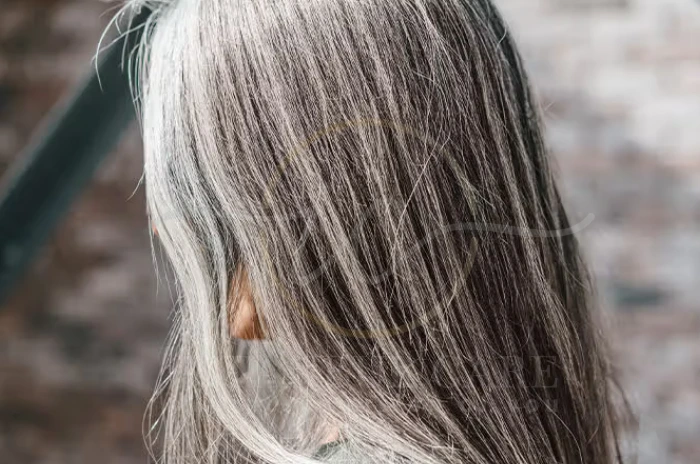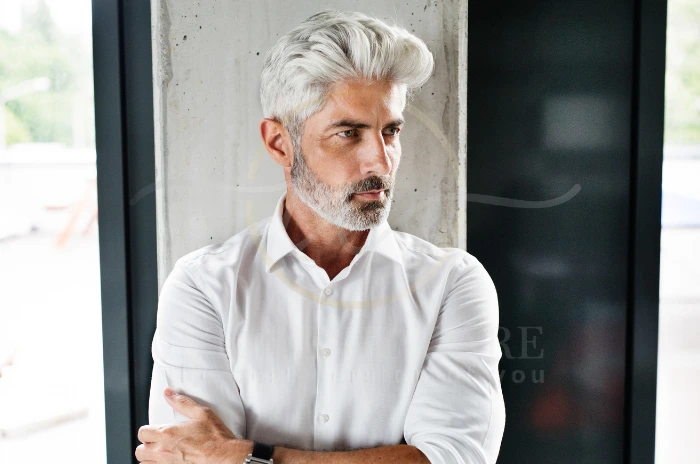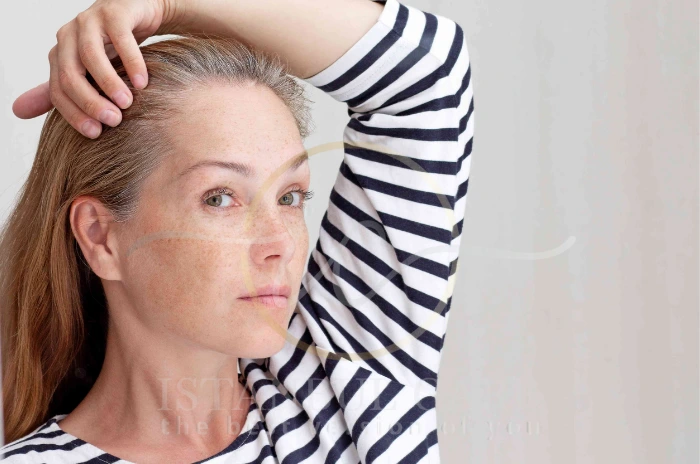The transition from pigmented to gray or white hair is a natural and complex process—one of the key Gray and White Hair Causes, that sparks curiosity, concern, and even pride. While some embrace the shift as a symbol of wisdom and elegance, others seek answers to why it happens, how to manage it, and whether it can be delayed. This guide explores the gray hair causes and care strategies you need to understand your hair’s aging journey and keep it healthy and vibrant.

What Causes Gray or White Hair
Role of Melanin and Hair Pigments
Hair color is determined by melanin, produced by melanocytes at the base of each hair follicle. As we age, these melanocytes slow down or stop producing melanin, leading to melanin loss and the appearance of gray or white strands. Hair pigmentation stem cells also decline, reducing melanin regeneration capacity. Melanin also plays a role in protecting hair from UV damage. Its depletion not only causes color loss but can also increase hair fragility.
Genetics and Timing of Graying
The most powerful determinant of graying is genetics. If your parents experienced early graying, you’re more likely to as well. Genetics of gray hair control the onset and rate, making some people gray in their 20s while others retain their natural color into their 50s. Scientific studies continue to explore the specific genes responsible for early graying. Understanding these can help in developing targeted hair care strategies.
Aging and Melanin Loss
Natural aging leads to a decrease in the activity of melanocytes and associated enzymes. This melanin decline in hair is gradual and influenced by cellular aging and environmental exposure. The accumulation of hydrogen peroxide in the follicles is another age-related factor disrupting melanin. This further explains the progressive whitening of hair strands.
Vitamin Deficiencies & Nutrient Imbalances
Deficiencies in vitamin B12, D3, E, iron, copper, and zinc can lead to vitamin deficiency gray hair. These nutrients are essential for melanin synthesis and follicle health. Poor dietary habits can accelerate these deficiencies. Regular blood tests can help detect imbalances early to support pigment retention.
Oxidative Stress, Smoking & Environmental Triggers
Free radicals from oxidative stress, pollution, and smoking damage melanocytes. Smoking and gray hair are closely linked, and smokers are significantly more likely to experience early graying. Airborne toxins and excessive sun exposure are environmental risks that compound oxidative damage. Lifestyle adjustments can help protect melanocyte function.
Medical Conditions & Autoimmune Issues
Conditions such as vitiligo, thyroid disorders, and canities subita (sudden graying) are associated with pigment loss. Autoimmune diseases may attack melanocytes, accelerating hair depigmentation. Poliosis and alopecia areata are also known to cause localized pigment loss. Consulting a dermatologist is key to accurate diagnosis and treatment.
Natural Aging vs. Premature Graying
Biological Aging Process
With age, reduced stem cell renewal, oxidative damage, and slower protein synthesis contribute to hair graying. This natural aging affects nearly everyone over time. Hormonal shifts during aging may also impact melanocyte survival. Age-related immune changes may contribute to follicle inflammation and graying.
Early Graying: Causes and Warning Signs
Premature gray hair is graying before age 20 in Caucasians, 25 in Asians, and 30 in African populations. Causes include genetics, stress, malnutrition, and underlying health issues. It’s important to rule out treatable causes through lab tests and medical consultation. Early detection can help in implementing preventive care strategies.
Characteristics of Gray or White Hair
Texture and Growth Changes
Gray hair is often drier, more brittle, and wiry due to reduced sebum production. Structural changes in the hair shaft alter the texture and reduce shine. Reduced melanin also alters the follicle structure, affecting curl pattern and thickness. Gray hair may also appear thinner or more voluminous depending on hair type.
Scalp Health Impact
The gray hair and scalp health relationship is crucial. Reduced melanin may leave the scalp more vulnerable to UV rays, irritation, and dryness. Maintaining proper hydration and protection is key to supporting scalp function. Specialized shampoos with antioxidants can aid in this effort.
Can Gray Hair Turn Back to Natural Color?
Rare Reversal Cases
Instances of repigmentation are rare but have occurred with medications (e.g., imatinib) or health interventions. However, these cases are the exception, not the rule. While rare, these cases offer insight into the complex biology of pigmentation. They also highlight the potential for future treatments targeting melanocyte regeneration.
Lifestyle Factors That May Slow Graying
A balanced diet, stress reduction, antioxidant intake, and avoiding smoking may slow the graying process. Still, reversing graying is uncommon. Including anti-inflammatory foods and adequate hydration can support overall hair health. Regular exercise may also help regulate stress hormones that impact pigment cells.

White Hair vs Gray Hair: What’s the Difference
Melanin Loss and Pigment Depletion
White hair contains no melanin, while gray hair still has residual pigments. The proportion of pigmented and non-pigmented strands creates a grayscale appearance. Melanin production is influenced by genetics and lifestyle, both of which affect hair’s appearance over time. Its absence results in more translucent and less light-reflective strands.
Underlying Causes: Stress vs Natural Aging
While grayscale hair or greyscale hair is often a sign of aging, chronic stress and medical triggers can contribute to premature whitening. Long-term stress triggers hormonal changes that can harm melanocyte activity. Conversely, natural aging is usually a gradual and genetically programmed process.
How to Care for Gray or White Hair
Gentle Care and Moisture
Use moisturizing shampoos and conditioners to combat dryness. Avoid heat styling and harsh chemicals that further dry or damage the strands. Avoiding sulfates and alcohol-based products is key to preserving moisture. Gentle brushing also helps minimize breakage and maintain a healthy cuticle layer.
Use of Purple or Silver Shampoos
To neutralize yellow tones, best shampoo for white hair options include violet or blue-toned formulas designed for gray hair care. These shampoos help maintain the vibrancy of silver tones by neutralizing brassiness. Use once or twice weekly to avoid buildup or dryness.
Sun Protection and Hair Health
Melanin protects hair from UV damage. As it declines, UV protection for gray hair becomes essential to prevent brittleness and color dullness. Wearing hats or using UV-blocking hair sprays can shield hair from sun-induced damage. This reduces dryness, brittleness, and discoloration in gray strands.
Adjusted Hair Care Routines
Wash less frequently, use sulfate-free products, and deep condition weekly. Choose serums or oils that improve texture and shine. Incorporating silk pillowcases may reduce friction and breakage during sleep. Routine trims also help manage coarse ends and improve overall look.
Preventing Yellowing: Purple/Shade Toners & UV Protection
Gray hair can yellow due to environmental pollutants or hard water. Use purple shampoos and sun protection for gray hair to maintain its brightness. Installing a shower filter can help remove minerals that contribute to discoloration. Antioxidant-rich hair serums offer additional protection from pollutants.
Hydration and Managing Coarse Texture
Deep hydration masks, leave-in conditioners, and natural oils like argan or jojoba help manage the coarse nature of gray hair. Avoid frequent use of heat tools, which can worsen texture issues in gray hair. Weekly oil treatments can restore elasticity and softness.
Common Causes and Prevention Methods for Gray Hair
| Cause of Graying | Possible Prevention or Support |
|---|---|
| Genetic Predisposition | None (inherited trait) |
| Melanin Depletion | Melanin-boosting care & diet |
| Vitamin B12 Deficiency | Vitamin B12 supplementation |
| Oxidative Stress | Antioxidant-rich foods |
| Smoking | Quit smoking |
| Thyroid Disorders | Thyroid function monitoring |
| Aging | Healthy aging habits |
| Stress | Stress reduction techniques |
When to See a Dermatologist
Underlying Health Concerns
Seek help if graying occurs with fatigue, hair loss, or other symptoms. This could signal thyroid, autoimmune, or nutritional issues. These symptoms can signal deeper hormonal or immune imbalances. Addressing the root cause early can help preserve overall hair and scalp health.
Unusual Patterns of Graying
Sudden, patchy, or asymmetric graying like poliosis warrants professional evaluation. If you notice patches of white or sudden changes, it’s important to seek expert advice. These changes might be early signs of autoimmune activity.
Diagnostic Steps and Tests
Doctors may perform blood work to assess vitamin levels, thyroid function, and autoimmune markers when premature graying reasons are unclear. These evaluations can help uncover nutritional gaps or chronic illnesses. A customized treatment plan may then be created to manage symptoms effectively.

Premature Graying: Key Triggers
Vitamin and Nutrient Deficiencies
Lack of B12, folic acid, or copper impairs melanin production. Supplementation may help slow further graying. Ensuring a balanced diet and regular supplementation may improve pigment cell function. Tracking levels annually helps maintain healthy hair over time.
Oxidative Stress and Free Radicals
High stress, poor diet, and pollution increase free radicals, contributing to oxidative stress gray hair formation. Antioxidants in the form of food or serums may help neutralize damage. Prioritizing rest and exercise can also minimize the internal stress load.
Medical Conditions and Autoimmune Diseases
Thyroid dysfunction, vitiligo, and pernicious anemia are commonly associated with early graying. Autoimmune-related hair changes are often reversible with early intervention. Treating these root issues can improve both color and texture.
Lifestyle Factors: Stress and Smoking
Chronic stress depletes stem cells, while smoking reduces oxygenation and directly damages follicles, accelerating graying. Implementing daily stress-relief habits may protect pigment-producing cells. Cutting back on tobacco supports better oxygen and nutrient delivery to follicles.
Why Gray Hair Sometimes Starts at the Temples
Anecdotal Evidence and Limited Research
Many notice their first gray hairs at the temples. While the reason is unclear, vascular differences and mechanical stress might play a role. This location may experience more friction or exposure to sunlight. More clinical studies are needed to confirm any anatomical reasoning.
Hair Thinning and Mechanical Stress Effects
Hair near the temples is often finer and more exposed to pulling, rubbing, and sunlight, possibly speeding up pigment loss. Consistent styling patterns can affect blood flow and stress at the temples. Awareness of these habits may delay localized graying.
Can Gray Hair Be Reversed or Prevented?
Nutritional Correction and Supplements
Correcting deficiencies in B vitamins, iron, and copper may help slow or prevent further graying. Hair-friendly nutrients like folate and selenium may enhance follicle longevity. Consultation with a healthcare provider ensures appropriate dosages.
Antioxidant-Rich Diet
Foods high in antioxidants (berries, leafy greens, nuts) can combat oxidative damage and support hair pigmentation stem cells. Colorful fruits and vegetables are excellent sources of antioxidants. Incorporating green tea and turmeric may offer additional anti-aging effects.
Quitting Smoking and Stress Management
Reducing smoking and practicing mindfulness, exercise, and quality sleep improves overall hair health. Mind-body practices such as meditation and yoga improve cellular resilience. These habits also enhance overall well-being and hormonal balance.
Emerging Research and Clinical Trials
Melanocyte stem cell therapy and pigmentation-restoring agents are under study but not yet widely available. Some therapies aim to reactivate dormant melanocytes. As these treatments advance, they may offer promising non-invasive options.
Vitamin Supplementation
Supplementing with biotin, B12, D3, and iron may support follicular function and melanin production in select cases. Consistency is key, as improvements may take several months to appear. Combining supplements with a nutrient-dense diet enhances results.
When to See a Doctor
Underlying Medical Issues
If gray hair is paired with fatigue, weakness, or hair loss, it might indicate systemic issues that require treatment. In some cases, graying may precede more noticeable health symptoms. Early detection allows for timely and effective treatment.
If Graying Is Sudden or Unusual
Canities subita (sudden graying) is rare but serious. Prompt evaluation ensures early diagnosis of underlying problems. It’s important not to ignore changes that happen rapidly or unexpectedly. Medical evaluation ensures any serious issues are ruled out early.
Common Myths & Facts About Gray Hair
Dye doesn’t cause graying; stress plays a role, but genetics are stronger. Plucking gray hairs doesn’t increase their number. Graying is primarily an internal biological change, not triggered by surface treatments. Being informed helps reduce stigma around silver hair.
Address rare reversal cases or research (e.g., imatinib drug studies)
Though rare, drug-induced reversal of graying has been documented. However, such results are unpredictable and not guaranteed. Such findings spark interest in drug-based approaches to graying. Continued investigation could lead to mainstream pigment-restoring therapies.
Biological Mechanisms Behind Graying
Melanocyte Function and Follicle Aging
Melanocytes reside in the hair bulb and generate pigment. Over time, DNA damage and oxidative stress impair their function. As follicles age, the ability to support active melanocytes weakens. Loss of these cells leads to permanent pigment absence in hair shafts.
Role of Oxidative Stress and Environmental Factors
Sun, pollution, and poor diet increase free radicals, hastening melanin loss and hair graying. Wearing protective hairstyles and minimizing chemical exposure may help. Diet and lifestyle also significantly influence long-term follicle health.
Does Stress Really Turn Hair Gray?
Stress and Hair Shedding (Telogen Effluvium)
Acute stress can trigger telogen effluvium, a condition where hair enters the resting phase and sheds. Regrowth may be gray or white. Hair may grow back in a different texture or color after such shedding. Supporting the body during recovery aids in more complete regrowth.
What Harvard’s Mouse Study Revealed
A Harvard study showed that stress activates nerves that damage melanocyte stem cells in mice, offering biological evidence of the stress gray hair link. Though studied in mice, the findings support a biological basis for the stress gray hair link. Human studies are ongoing to verify similar pathways.
Speak with our expert Hair Transplantation specialists

Speak with our expert Hair Transplantation specialists
We’re ready to answer your questions
FAQs for Understanding Gray and White Hair Causes Care and Prevention
The main cause is the reduction of melanin production due to aging, genetics, oxidative stress, and nutrient deficiencies.
Yes. Gray hair has partial pigmentation, while white hair lacks all melanin, resulting in a completely pigment-free strand.
Yes. It may indicate vitamin B12 deficiency, thyroid disease, or autoimmune conditions and should be evaluated if it occurs early or suddenly.
Rarely. Some medications or treatments may cause temporary repigmentation, but consistent reversal is uncommon.
Use moisture-rich, sulfate-free products, purple shampoos to prevent yellowing, and avoid harsh styling to maintain softness and shine.
Chronic stress can contribute to graying by depleting melanocyte stem cells, but it usually accelerates the process rather than directly causing it.
Yes. A diet rich in antioxidants, B vitamins, iron, and copper may help support melanin production and slow graying.
If your hair grays suddenly, unevenly, or with other symptoms like fatigue or thinning, medical evaluation is recommended.

